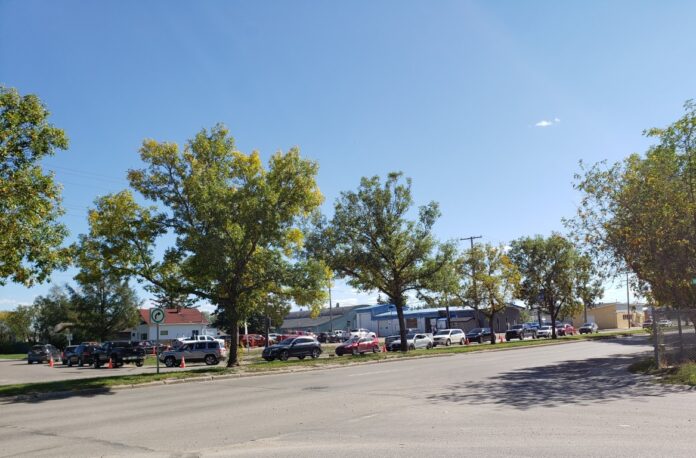Unless you are fully vaccinated and showing no symptoms, everyone who tests positive for COVID-19 is once again required to self-isolate for 10 days.
The province announced several changes and a new public health order on Friday to address the pressures on the health system as COVID hospitalizations continue to climb.
“Those who are close contacts of an individual who has tested positive and are unvaccinated, will also be required to self-isolate for 10 days,” said Premier Scott Moe in an online news conference on Sept. 10.
Vaccinated people identified as close contacts do not have to self-isolate but are required to self-monitor and seek testing if they have symptoms.
The government is now dealing with growing cases of increased severity and increased symptoms almost entirely in unvaccinated people, said Moe.
As of Sept. 10, there were 151 people receiving in-patient care and 39 in ICU in the province.
With test sites getting busier, the province is also expanding testing capacity through third-party providers and also by procuring more publicly funded testing resources.
More rapid testing resources will also be available to Saskatchewan residents with the anticipated delivery of 500,000 rapid antigen tests and another 500,000 coming after that.
The rapid tests will be made available to long-term care and personal care facilities, shelters, group homes and schools for routine testing. Businesses will also be able to use them for workplace screening.
The tests will be used to support the SHA’s Test to Protect program, and will also be available to health care workers, dentists, first responders and pharmacists for self-testing and to schools for students under the age of 12 and their families to use for at-home testing.
Moe highlighted what happens when people choose not to get vaccinated.
“By choosing to not get vaccinated, you are choosing to put yourself at increased risk of getting COVID and also a significantly increased risk of experiencing severe outcomes from this virus,” he said.
“By choosing to not get vaccinated, you are increasing the risk to those who don’t have a choice, for example our children under the age of 12. You are placing tremendous strain on our health care systems filling up our ICU beds and burdening many of our health care workers in this province.”
System capacity
With capacity an increasing concern, Moe said the province is taking steps to deal with the problems.
“Our preparations for COVID-19 have ensured that we do have ample bed space. We do have the critical equipment in place and we do have all of the resources that required,” he stated. “But an ICU bed and a ventilator are just equipment and we have enough but what we need are front line health care workers.”
Time is of the essence, he said. In July 2021 over 17,000 shifts went unfilled in health care facilities across the province, an increase of 160 per cent of the previous July.
To handle the staffing shortage, Moe said the province is talking to all of the involved unions to make an agreement. If the agreement is not forthcoming in the next few days, the province will re-enact a previous labour mobility agreement on Sept. 13.
The province is also turning to the private sector for resources such as testing and contact tracing from third party providers.
“This will also ensure our health care workers are able to stay on the front lines, where they are most needed at the moment,” he said.
The province is also reducing non-essential health services such as non-critical or elective services in order to make room to respond to the COVID case load.
The temporary service disruptions resulting will be as localized and time-limited as possible to limit impact on patients and be announced as they are ready for implementation through the SHA’s normal service disruption public notification processes.
About 8,500 MRI and CT scans will be bought from private providers and an additional 2,300 scans will be done in smaller hospitals.
The SHA will further increase volumes throughout their imaging facilities, including in places such as Melfort which recently opened a new CT scanner in their hospital, with appointments available to patients who are willing to go to centres outside of their home communities.
Mandatory vaccination/negative test for SHA employees
While the SHA had previously announced a proof of vaccination policy for certain frontline health care workers, this policy will now apply to all SHA employees. Exactly how it will work out is still being developed.
Booster Doses
With the administration of “booster” doses commencing this week for immunocompromised individuals and long-term care residents, Saskatchewan will soon start providing widespread access to booster doses for the broader public.
Beginning in October, COVID-19 booster shots will soon be made available for the Saskatchewan senior population, with further expansion to the broader vaccinated public throughout the winter.
Further details including eligibility for boosters, sequencing, and timing of booster administration will be announced in the weeks ahead, contingent on vaccine allocations from the federal government.
Verifiable Proof of Vaccination Record
Saskatchewan’s verifiable record of vaccination is in its final stages of development and will be launched during the week of September 20.
Residents who are currently registered for eHealth Saskatchewan’s My Sask Health Record will be able to download their vaccine record, including a unique QR code, and protect personal health information.
Businesses, organizations, post-secondary institutions and municipalities that require proof of vaccination will be able to download a separate app to securely scan these QR codes to verify vaccination records without retaining or viewing any personal health information.
More details regarding the vaccination records, QR codes and the verification app will be available in the days prior to the launch.


